The emphasis on customer experience has become more crucial than ever. You will find it interesting to know that 63% of customer experience decision-makers acknowledge the growing significance of customer experience, with 88% agreeing that customizing this experience is vital for business success.
However, many find themselves at a crossroads, lacking the necessary resources and expertise to effectively enhance the digital customer journey. This is where the concept of a customer journey map becomes a necessity.
Imagine the first time you visit a new coffee shop. The experience, from the welcoming aroma at the door to the ease of placing your order and the ambiance as you enjoy your coffee, plays a pivotal role in whether you’ll return or recommend it to others.
Now, apply this analogy to any business, from local coffee shops to global tech giants. Every customer interaction with a business molds their perception and influences their decision-making process. Customer journey maps are instrumental in this context, serving not just as visual aids but as strategic tools that enable businesses to comprehend and improve every aspect of the customer’s experience.
By meticulously mapping out the customer’s journey, from their initial awareness to the post-purchase phase, businesses can pinpoint critical areas for enhancement, tailor their services to align with customer expectations and forge enduring relationships.
This approach is crucial for businesses of all sizes. Whether spearheading a startup or managing a major corporation, leveraging customer journey maps can transform your customer interactions and propel your business to new heights of success.
In this blog, we delve into how large and small businesses utilize customer journey maps to refine customer interactions, improve service delivery, and ultimately cultivate stronger, more meaningful customer relationships.
The customer journey map is more than a tool; it’s a roadmap to deepening customer connections and achieving business excellence in a world where customer experience is paramount.
What are Customer Journey Maps?
Customer journey maps are visual representations that show a customer’s steps when interacting with a company, from first learning about the brand to forming a long-term relationship.
Customer journey maps use customer feedback and data to highlight important moments, emotions, and challenges customers face.
This map is used by businesses to understand and improve how customers experience their services or products. It’s regularly updated to keep up with changing customer needs and market trends, helping businesses stay focused on their customers.
The Different Types of Customer Journey Maps
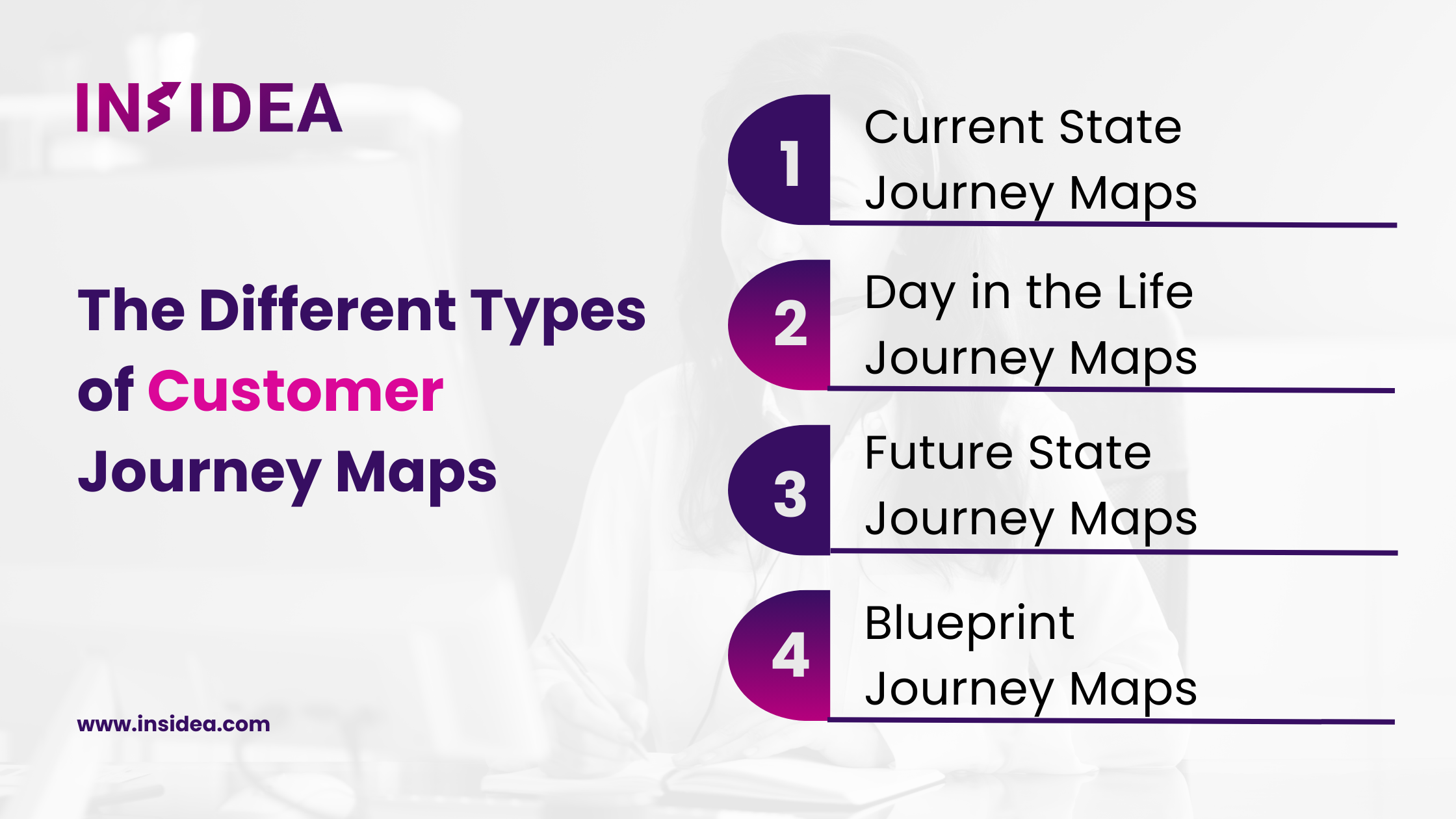
Different customer journey maps are vital business tools tailored to specific objectives and insights. While similar in their intent to enhance customer experience, these maps differ in focus and application.
1. Current State Journey Maps
Ideal for businesses looking to refine and optimize their existing customer interactions and services.
These customer journey maps focus on the present interactions between customers and the business, helping identify and address existing issues in the customer experience.
For example, a retail store might use a current state map to analyze the checkout process, identify pain points like slow checkout lines or confusing signage, and then work on solutions to streamline the shopping experience.
2. Day in the Life Journey Maps
Suitable for companies seeking to innovate and create new products or services by understanding broader customer lifestyles and challenges.
These customer journey maps delve into customers’ or prospects’ broader lifestyles and daily challenges and go beyond direct interactions with the company’s products or services, offering insights into unmet customer needs.
For instance, a fitness wearables company might use this type of map to understand the daily physical activities of its target market, leading to the development of more personalized fitness tracking features.
3. Future State Journey Maps
Beneficial for organizations planning significant changes or new offerings, helping to align these future developments with customer needs and expectations.
These are particularly beneficial for organizations planning significant changes or introducing new offerings. They help businesses align these future developments with customer needs and expectations.
A good example is a software company envisioning how advances in machine learning could enhance user experience in the future, leading to the development of more intuitive and adaptive software solutions.
4. Blueprint Journey Maps
Crucial for businesses undergoing transformation or those needing a deep dive into the systemic changes required to enhance customer experience.
Blueprint customer journey maps start with an existing or future state journey map and add layers of operational elements like processes, policies, and technologies. They’re perfect for understanding the root causes of issues or planning the infrastructure needed for future experiences.
For example, an airline company might use a blueprint map to improve the overall passenger experience. This map would not only cover the customer’s journey from booking a flight to reaching their destination but also the roles of flight and ground staff, the efficiency of the check-in process, and the impact of technology like mobile check-ins and digital boarding passes.
The Benefits of Customer Journey Mapping
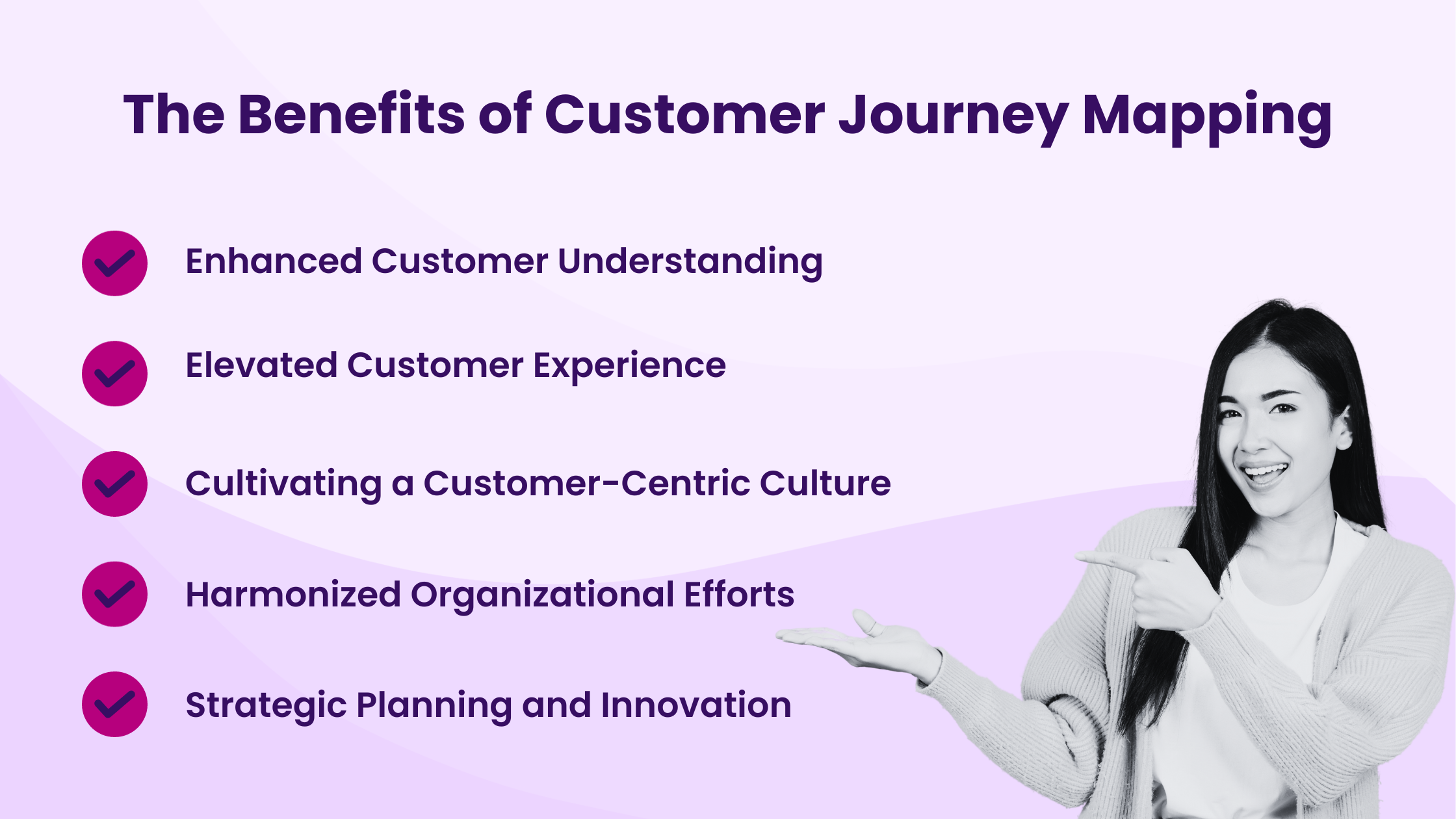
Incorporating customer journey maps into a business strategy can yield transformative results when approached with a focus on actionable outcomes. Here’s how these benefits can be realized:
1. Enhanced Customer Understanding
By actively collecting and analyzing customer feedback, businesses can gain a profound understanding of their customers’ needs, behaviors, and pain points. This process gathers data and delves deep into the customer psyche, enabling more informed decisions about product improvements and service enhancements.
2. Elevated Customer Experience
Identifying and prioritizing key pain points in the customer journey allows businesses to implement changes strategically. Whether streamlining a checkout process or enhancing customer support, these targeted improvements are geared toward elevating the overall customer experience. The key lies in continuously assessing the impact of these changes, ensuring they genuinely resonate with the customers.
3. Cultivating a Customer-Centric Culture
Embedding a culture of customer empathy throughout the organization is pivotal. By educating employees about the importance of customer perspective and encouraging regular engagement with customer journey maps, businesses can foster decision-making processes that truly consider customer needs. Celebrating customer service excellence further reinforces this empathetic approach.
4. Harmonized Organizational Efforts
Sharing insights from customer journey maps across all departments fosters an organization-wide alignment with customer expectations. This approach transcends departmental boundaries, ensuring a unified strategy for enhancing customer touchpoints. Establishing common customer satisfaction goals and KPIs encourages a collaborative effort toward improving the customer experience.
5. Strategic Planning and Innovation
Integrating the insights of customer journey maps into strategic planning allows for a more targeted approach to innovation. Keeping the journey map updated with evolving customer behaviors and market trends ensures businesses stay ahead. This ongoing adaptation and innovation process is about keeping pace, anticipating, and shaping future customer needs.
The Elements of Good Customer Journey Maps
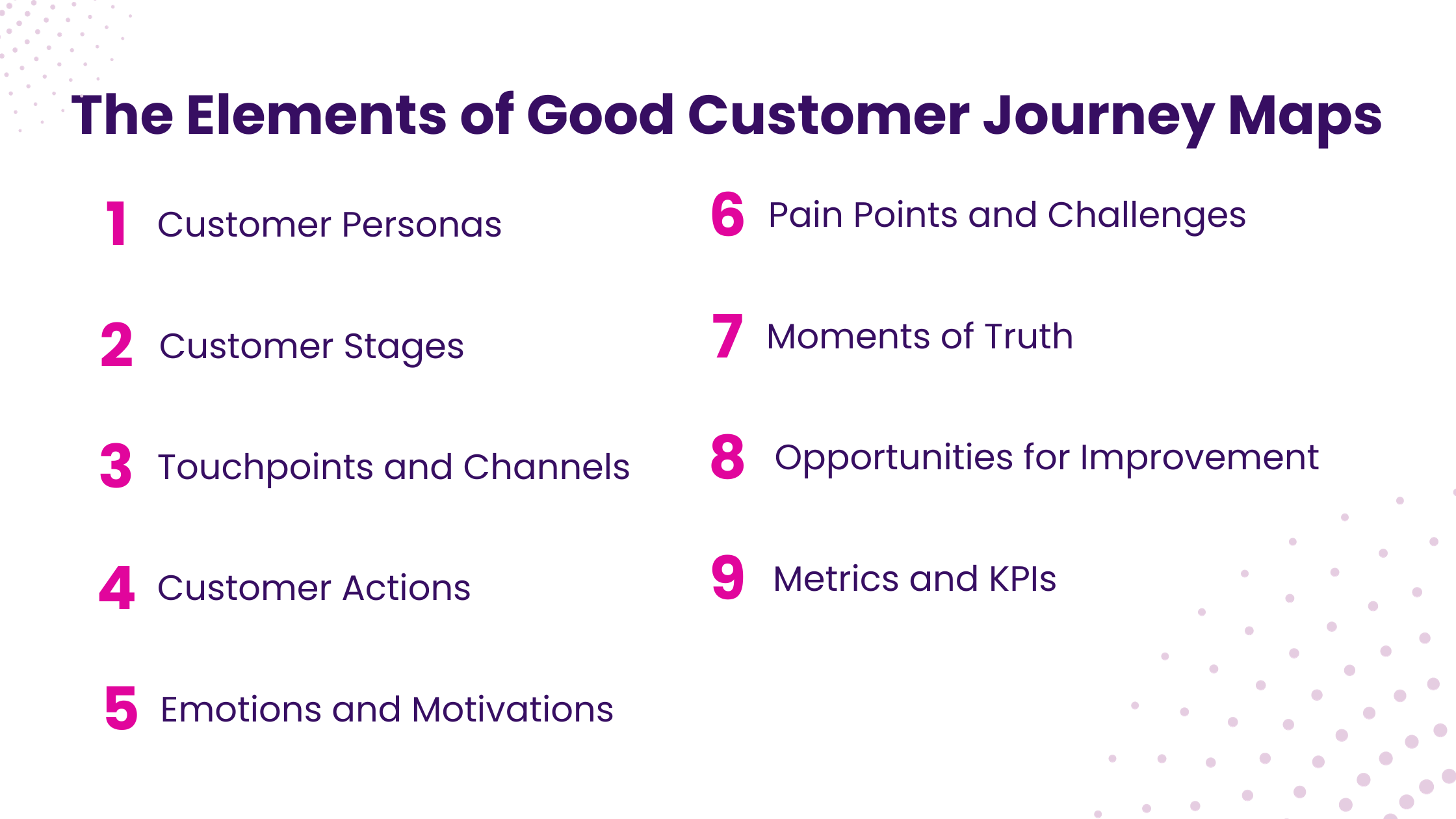
Good customer journey maps are detailed and insightful tools that help businesses understand and improve customer experiences. Here are the key elements that make up an effective customer journey map:
- Customer Personas: Start with detailed profiles of your typical customers. These personas should include demographic information, behaviors, motivations, and goals.
- Customer Stages: Outline the different stages a customer goes through in their journey with your business, from initial awareness and consideration to purchase and post-purchase experiences.
- Touchpoints and Channels: Identify all the points where customers interact with your business, whether through your website, in a physical store, on social media, or through customer service.
- Customer Actions: Document customers’ actions at each stage of their journey. This could include visiting a website, making a purchase, or contacting customer service.
- Emotions and Motivations: Capture the emotions and motivations of customers at each stage. Understanding customers’ feelings and what drives them is crucial for creating a more empathetic customer experience.
- Pain Points and Challenges: Highlight customers’ obstacles or frustrations throughout their journey. These are areas where improvements can significantly enhance the customer experience.
- Moments of Truth: Identify key moments critical to winning or losing a customer. These are the make-or-break points where the customer’s experience can greatly influence their overall perception of your brand.
- Opportunities for Improvement: Based on the analysis, pinpoint areas where you can enhance the customer experience, whether it’s streamlining a process, improving a product, or enhancing customer service.
- Metrics and KPIs: Include relevant metrics and key performance indicators to measure the success of different customer journey stages. These can help track improvements over time.
By incorporating these elements, customer journey maps become a comprehensive guide to help businesses understand and cater to customers more effectively, improving satisfaction and loyalty.
The Customer Journey Mapping Process
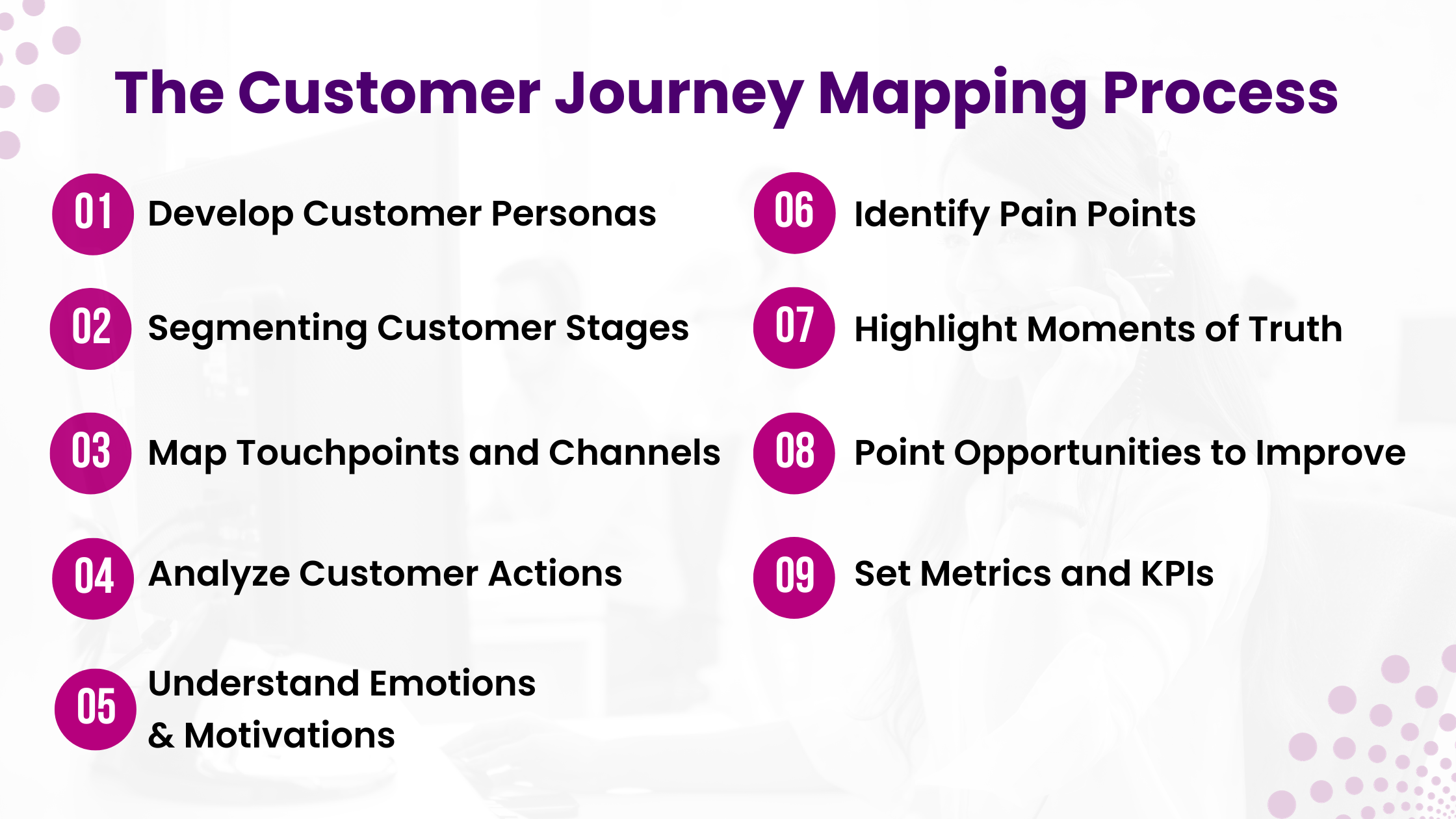
Creating effective customer journey maps involves deeply understanding various components that shape a customer’s interaction with a business. To make each component actionable, here’s how to approach them:
- Develop Customer Personas: Focus on creating detailed, data-driven representations of your target customers. This involves gathering and analyzing demographic, psychographic, and behavioral data to form a clear picture of who your customers are. This step is crucial for tailoring the journey to address their needs and preferences.
- Segment the Customer Stages: Break down the customer journey into clear, distinct stages like awareness, consideration, decision, and post-purchase. Each stage should be defined by the customer’s mindset and the actions they are likely to take. This segmentation allows for targeted strategies at each point in the journey.
- Map Touchpoints and Channels: Identify and document all points of interaction and the channels through which they occur. This involves thoroughly analyzing how customers engage with your business across various platforms and mediums. Understanding these touchpoints is key to optimizing interactions at each stage.
- Analyze Customer Actions: Carefully document customers’ actions during each journey stage. This detailed analysis helps understand customer behavior and identify areas where they might need support or additional information.
- Understand Emotions and Motivations: Capture and analyze customers’ emotional experiences and motivations at each stage. This involves empathizing with customers and understanding their emotional journey, which is crucial for enhancing their overall experience.
- Identify Pain Points: Look for customer challenges and frustrations. This step is about turning problems into opportunities by identifying and addressing areas that negatively impact the customer experience.
- Highlight Moments of Truth: Recognize and emphasize the critical points in the journey that significantly impact the customer’s perception of your brand. This involves strategizing to enhance positive moments and mitigate negative ones.
- Point Opportunities to Improve: Based on the insights from the journey map, identify specific areas for enhancing the customer experience. This could involve process changes, product improvements, or customer service enhancements.
- Set Metrics and KPIs: Define and implement metrics and key performance indicators for each journey stage. This step is about establishing a continuous measurement and improvement system, ensuring that the customer experience always evolves positively.
Steps to Create Customer Journey Maps
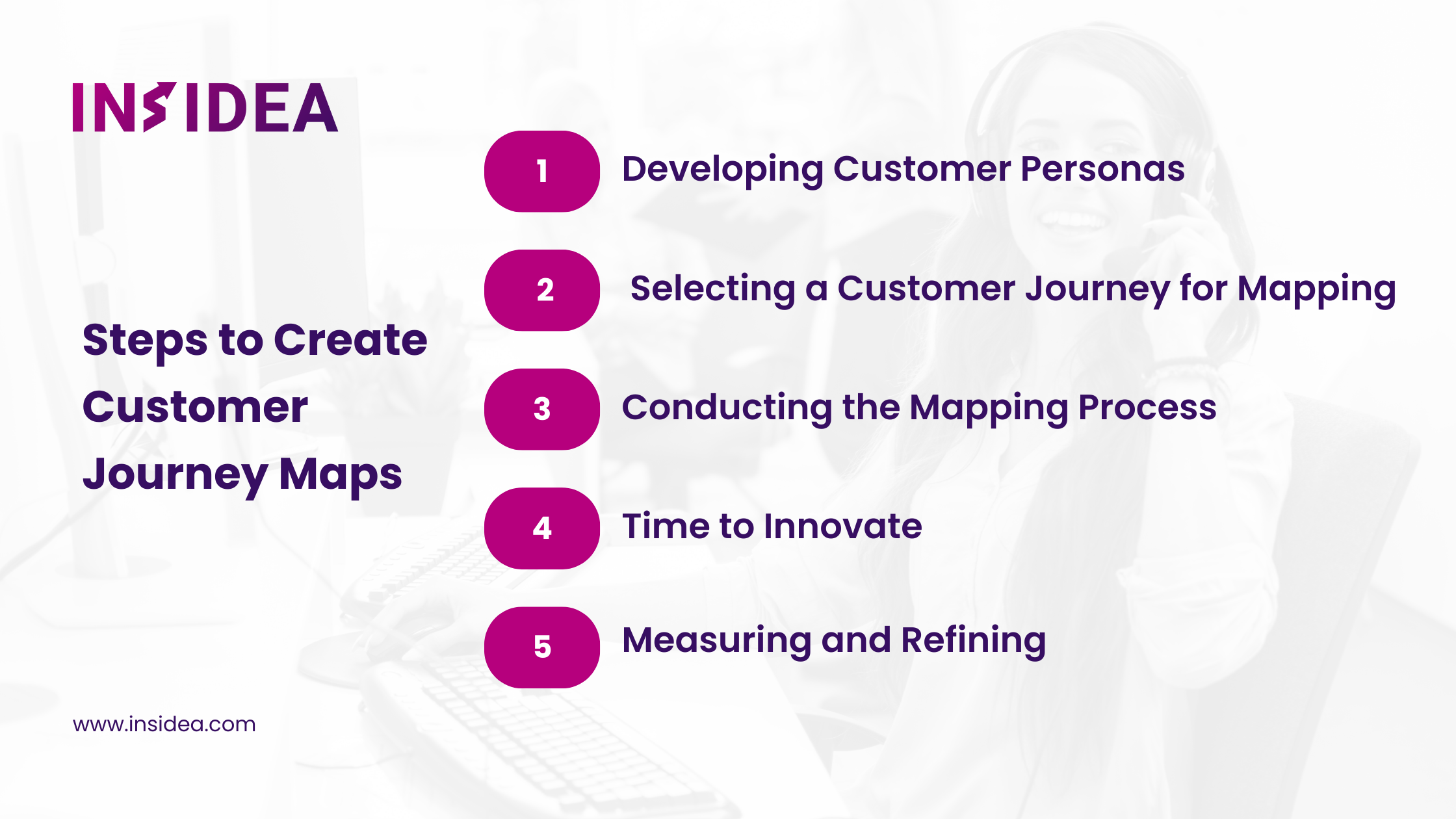
Creating customer journey maps involves a structured and detailed process to understand and improve how customers interact with your business. Here’s how you can approach it:
Step 1: Developing Customer Personas
First, let’s get to know who we’re mapping this journey for. This step is all about creating detailed customer personas. Gather data to understand their profiles thoroughly—what’s their age, job, personal, and professional goals?
This isn’t just about broad categories; it’s about getting to the heart of who your customers really are. Understanding them is key whether they’re your regulars, big spenders, or newcomers. And yes, keep it simple at first—no more than three personas. Here’s a fun part: involve people from different parts of your organization. They’ll bring unique insights to the table.
Step 2: Selecting a Customer Journey for Mapping
Next, let’s pick a journey to focus on. Which aspect of your customers’ experience are we going to map? It could be their first purchase, a service renewal, or maybe an issue resolution journey. Choose one that’s either the most common or the most impactful. Imagine laying out this journey step by step – what does it look like from start to finish?
Step 3: Conducting the Mapping Process
Now, let’s get into the nitty-gritty. Who’s involved in this journey? What steps do they take? More importantly, how do your customers feel at each stage? This is where you identify that critical moment—the make-or-break point—that can shape their perception of your brand.
Understand their needs throughout and how they might change, especially during not-so-great experiences. Don’t forget to think about how you’ll measure success here. What KPIs will tell you if you’re hitting the mark?
Step 4: Time to Innovate
This is where creativity comes in. Based on what we’ve mapped, how can we make this journey better? Let’s brainstorm. No idea is too out there at this stage. Then, sift through these ideas. Are they doable? Do they add real value? This isn’t just about making changes; it’s about making the right changes.
Step 5: Measuring and Refining
Finally, it’s all about continuous improvement. Set up a system to measure how well the journey is going. Are we meeting our KPIs? Where can we do better? This is an ongoing process—always tweaking, always refining, always aiming to provide a better experience for our customers.
Examples of Customer Journey Maps
- Amazon
You’re browsing through Amazon, the vast online marketplace. Every click you make, from viewing a product to adding it to your cart, is part of a meticulously crafted journey. Amazon’s customer journey map is like a grand adventure novel, incredibly detailed and extensive.
For instance, when you see a product you like and click on it, you’ve just moved through the “impressions” stage. If you add it to your list or cart, you progress through the “Conversion Funnel.” And when you finally make that purchase, you’ve reached a crucial milestone in the journey. Amazon tracks all these steps, from the initial impression to the repeat purchase, using various metrics. It’s a journey crafted to keep you engaged and make your shopping experience smooth and enjoyable.
- Excel
Imagine you’re a business owner looking to purchase a software solution like Hootsuite or MailChimp. Unlike the vast Amazon journey, your path is more straightforward and digital. The journey map for such a purchase could be laid out in a simple Excel spreadsheet.
Each stage, from discovering the product on social media to researching via blog posts, is a clear, distinct step in your journey. The process is quick, with digital touchpoints efficiently guiding you towards making a decision. It’s a journey with minimal barriers, designed to be as swift and hassle-free as possible.
- HubSpot
In HubSpot’s world, your journey starts as a ‘Stranger’—you’re just getting to know what HubSpot is all about. As you engage more by subscribing to a newsletter or downloading an e-book, you transition into a ‘Subscriber’ or a ‘Lead.’ This is where HubSpot’s map gets interesting.
The journey is broken down into smaller, more focused stages. For instance, as you move from being a casual subscriber to a Marketing Qualified Lead (MQL), your interactions with HubSpot change. Initially, you might just be browsing content, but as an MQL, you might start receiving more personalized communications, possibly even direct interactions with sales reps.
HubSpot’s journey map recognizes that not everyone is ready to buy immediately. Some need more nurturing and more information before they make a decision. This is where the map’s beauty lies – in understanding that different people are at different stages, and each requires a unique approach. It’s about giving you the right experience at the right time, ensuring you’ve all the support and information you need if and when you decide.
Using these customer journeynmaps, you can improve their experience from start to finish. This not only makes your customers happier but also helps your business grow. It’s all about learning from your customers and improving with them.
By consistently applying the insights from customer journey maps, you turn every interaction into an opportunity for enhancement. In the long run, this approach builds a loyal customer base and creates a strong, customer-focused brand identity. Remember, every step in the customer’s journey is a chance to excel and stand out in a crowded market.
Unlock Customer Service Excellence with INSIDEA’s Expertise!

Are you ready to transform your customer service and take your customer experience to the next level? INSIDEA is here to guide you through every step of the way, ensuring that your support team is empowered to deliver exceptional service.
As experts in customer support solutions, we pride ourselves on helping businesses optimize their support strategies for maximum efficiency and customer satisfaction. Reach out today to discover how INSIDEA can revolutionize your customer support and contribute to your business success!
Tailored Support Strategies: At INSIDEA, we understand that every business is unique. That’s why we work closely with you to develop customized support strategies that align with your specific needs and goals.
Industry Expertise: Our team brings a wealth of experience and industry knowledge to the table, ensuring that you have access to the best practices and insights in customer support.
Customer Commitment : Your customers’ happiness is our top priority. We are dedicated to helping you exceed their expectations and foster long-lasting relationships.
Ready to elevate your customer support experience? Book a meeting with our experts today and start your journey towards outstanding customer service and satisfaction.








































